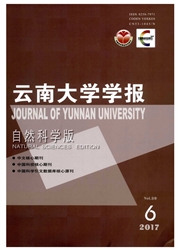

 中文摘要:
中文摘要:
在优化了载体膜种类、引发剂与交联剂用量以及载体膜在预聚合溶液中的浸泡时间基础上,以聚偏氟乙烯(PDVF)为载体膜,甲基丙烯酸(MAA)为功能单体,乙二醇二甲基丙烯酸酯(EDMA)为交联剂,固定模板、单体及交联剂的加入量比为1:4:8,在乙腈中用AIBN引发聚合反应,制备了一种对香豆素具有较高吸附容量(0.1518mmol/g)和理想印迹因子(2.09)的香豆素分子印迹复合膜.用红外光谱和扫描电镜表征了膜的结构与形貌,探讨了膜的传质机制及其渗透选择性.结果表明,在浓度差驱动下,该膜通过溶解一扩散机理进行传质,并在有干扰物存在时,对香豆素具有良好的分离选择性,从桂枝甲醇粗提液中提取分离香豆素的回收率达到了89.6%.
 英文摘要:
英文摘要:
A coumarin molecularly imprinted composite membranes (MIM) with high binding capacity (0. 1518 retool/g) and satisfactory imprinting factor (2.09) was prepared in acetonitrile by thermal initiation with azobisisobutyronitrile (AIBN) using coumarin as template, polyvinylidene fluoride (PVDF) membrane as supporting membrane, methacrylic acid (MAA) as functional monomer, ethylene glycol dimethacrylate (EDMA) as crosslinker, and the molar ratio of template, monomer and crosslinker was 1 : 4: 8. IR spectra and scanning elec- tron microscope (SEM) were used to characterize the structure and surface of the obtained MIM, respectively. The mechanisms for transport together with the permeation selectivity were studied. The results indicated that the imprinted membrane, which demonstrated satisfactory recognition selectivity towards the template molecules in the presence of other compounds and the transport selectivity could be explained by the dissolution - proliferation mechanism, could be used for separation of coumarin from methanol extract of Cinnamomum cassia Presl with a recovery of 89.6%.
 同期刊论文项目
同期刊论文项目
 同项目期刊论文
同项目期刊论文
 期刊信息
期刊信息
